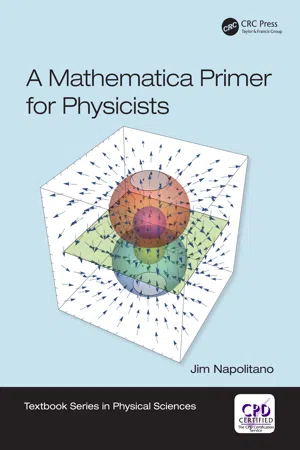
- 200 pages
- English
- ePUB (mobile friendly)
- Available on iOS & Android
A Mathematica Primer for Physicists
About this book
"…an excellent text for either a short course or self-study… Professor Napolitano has figured out what students really need, and found a way to deliver it… I have found everything he writes to be worthy of my serious attention…"
—Peter D. Persans, Professor of Physics and Director, Center for Integrated Electronics, Rensselaer Polytechnic Institute
Learn how to use Mathematica quickly for basic problems in physics. The author introduces all the key techniques and then shows how they're applied using common examples. Chapters cover elementary mathematics concepts, differential and integral calculus, differential equations, vectors and matrices, data analysis, random number generation, animation, and visualization.
- Written in an appealing, conversational style
- Presents important concepts within the framework of Mathematics
- Gives examples from frequently encountered physics problems
- Explains problem-solving in a step-by-step fashion
Jim Napolitano is professor and chair in the Department of Physics at Temple University. He is the author of other textbooks, including co-author with Alistair Rae of Quantum Mechanics, Sixth Edition, also published by Taylor & Francis / CRC Press.
Frequently asked questions
- Essential is ideal for learners and professionals who enjoy exploring a wide range of subjects. Access the Essential Library with 800,000+ trusted titles and best-sellers across business, personal growth, and the humanities. Includes unlimited reading time and Standard Read Aloud voice.
- Complete: Perfect for advanced learners and researchers needing full, unrestricted access. Unlock 1.4M+ books across hundreds of subjects, including academic and specialized titles. The Complete Plan also includes advanced features like Premium Read Aloud and Research Assistant.
Please note we cannot support devices running on iOS 13 and Android 7 or earlier. Learn more about using the app.
Information
Contents
How to read this book
Preface
Table of contents
- Cover
- Halftitle
- Title
- Copyright
- Table of Contents